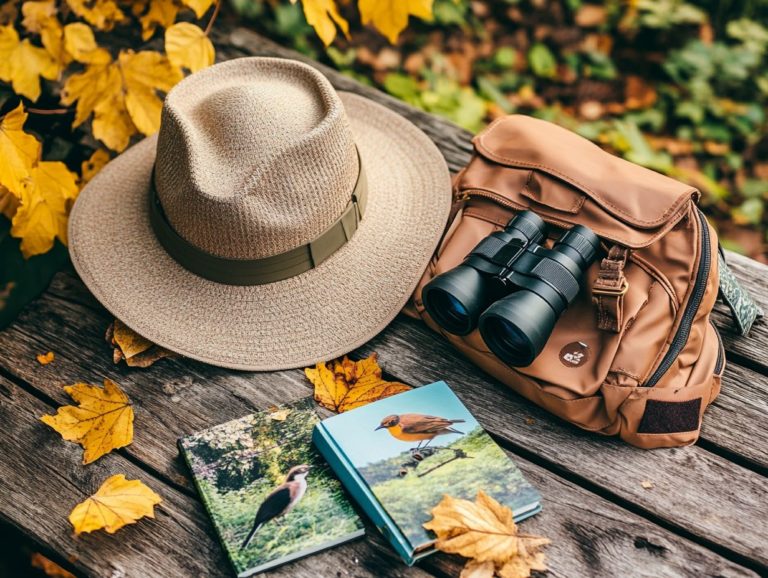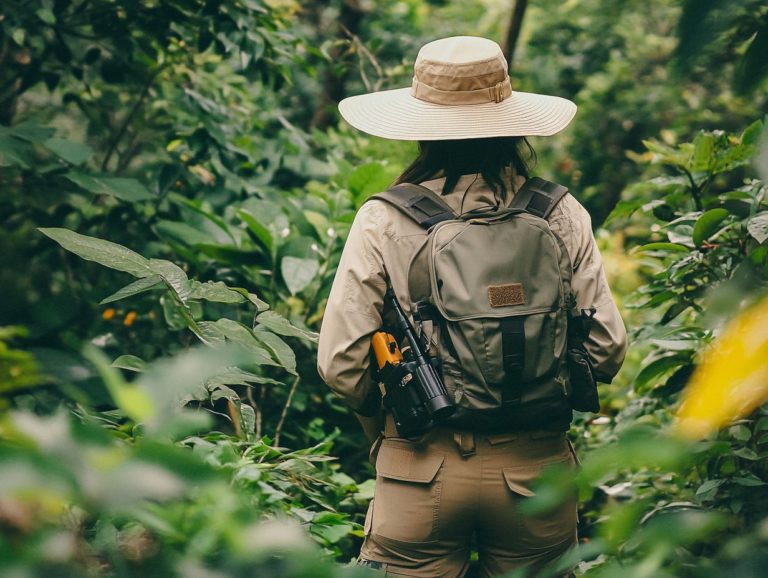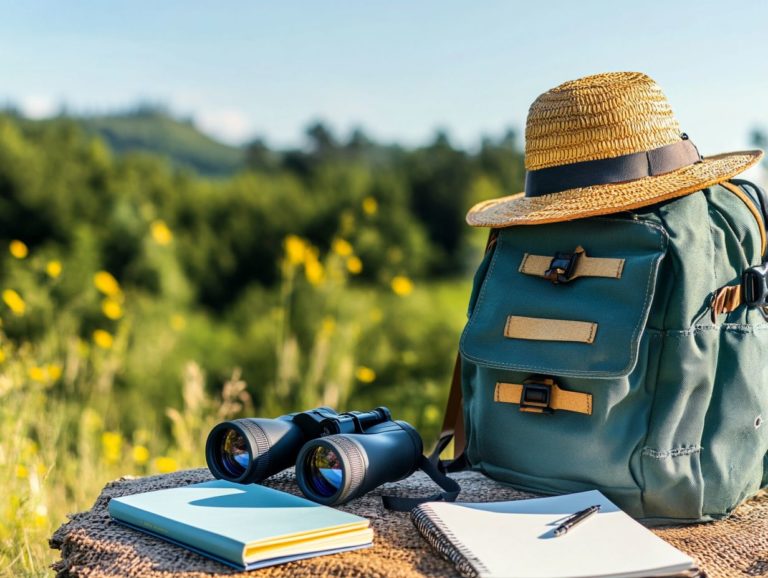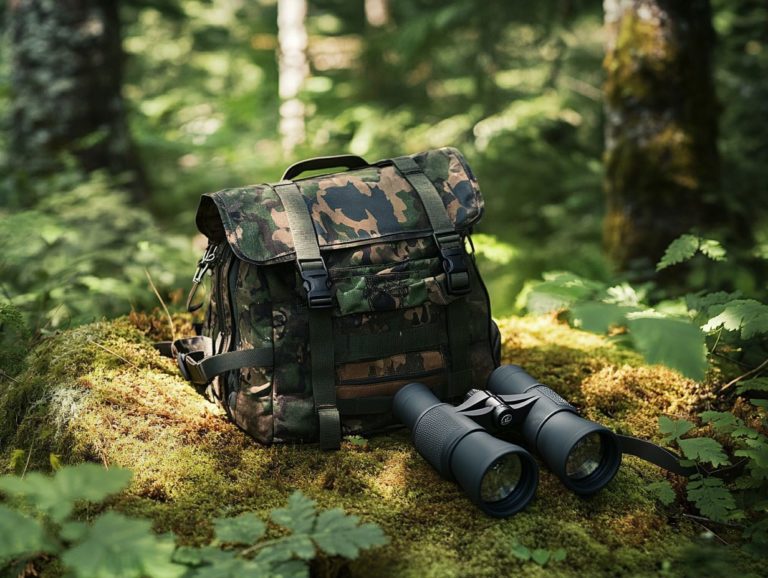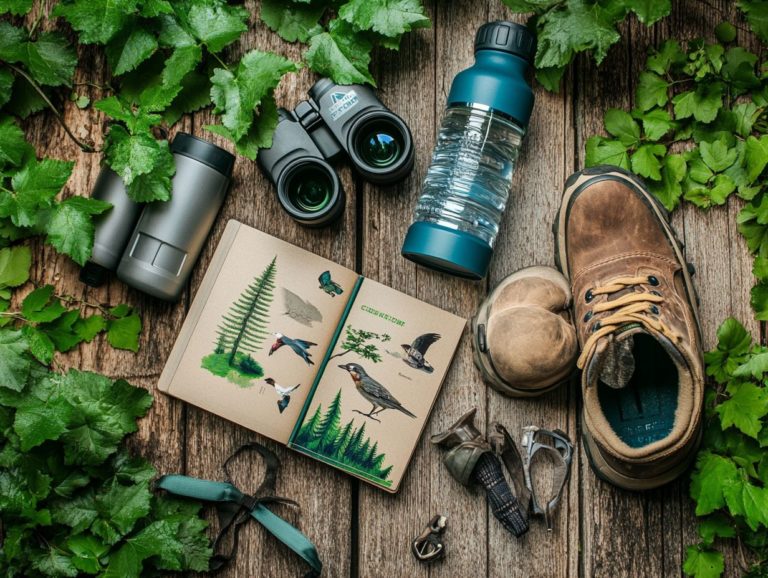Bird Watching Gloves: What to Look For
Bird watching is an exhilarating pursuit, yet it presents its own unique set of challenges.
One often overlooked aspect is the significance of selecting the right gloves. Whether you’re facing the elements or engaging with wildlife, the right gloves can make a world of difference.
This article delves into the essential features you should consider, from material and fit to grip and dexterity.
- You ll find a comparison of fingerless versus full-finger options.
- A discussion on waterproof versus breathable designs.
- Tips for choosing the ideal gloves to enhance your bird watching adventures.
You ll also find care tips to help your gloves last through many outings.
Are you ready to elevate your bird watching experience? Let s dive in!
Contents
- Key Takeaways:
- Why Bird Watching Gloves are Important
- Features to Consider in Bird Watching Gloves
- Types of Bird Watching Gloves
- Choosing the Right Gloves for Your Needs
- Proper Care and Maintenance of Bird Watching Gloves
- Frequently Asked Questions
- What should I consider when shopping for bird watching gloves?
- Do I need specialized gloves for bird watching?
- What type of material is best for bird watching gloves?
- Can I use any type of gloves for bird watching?
- What features should I look for in bird watching gloves?
- How do I know if the gloves will fit me?
Key Takeaways:
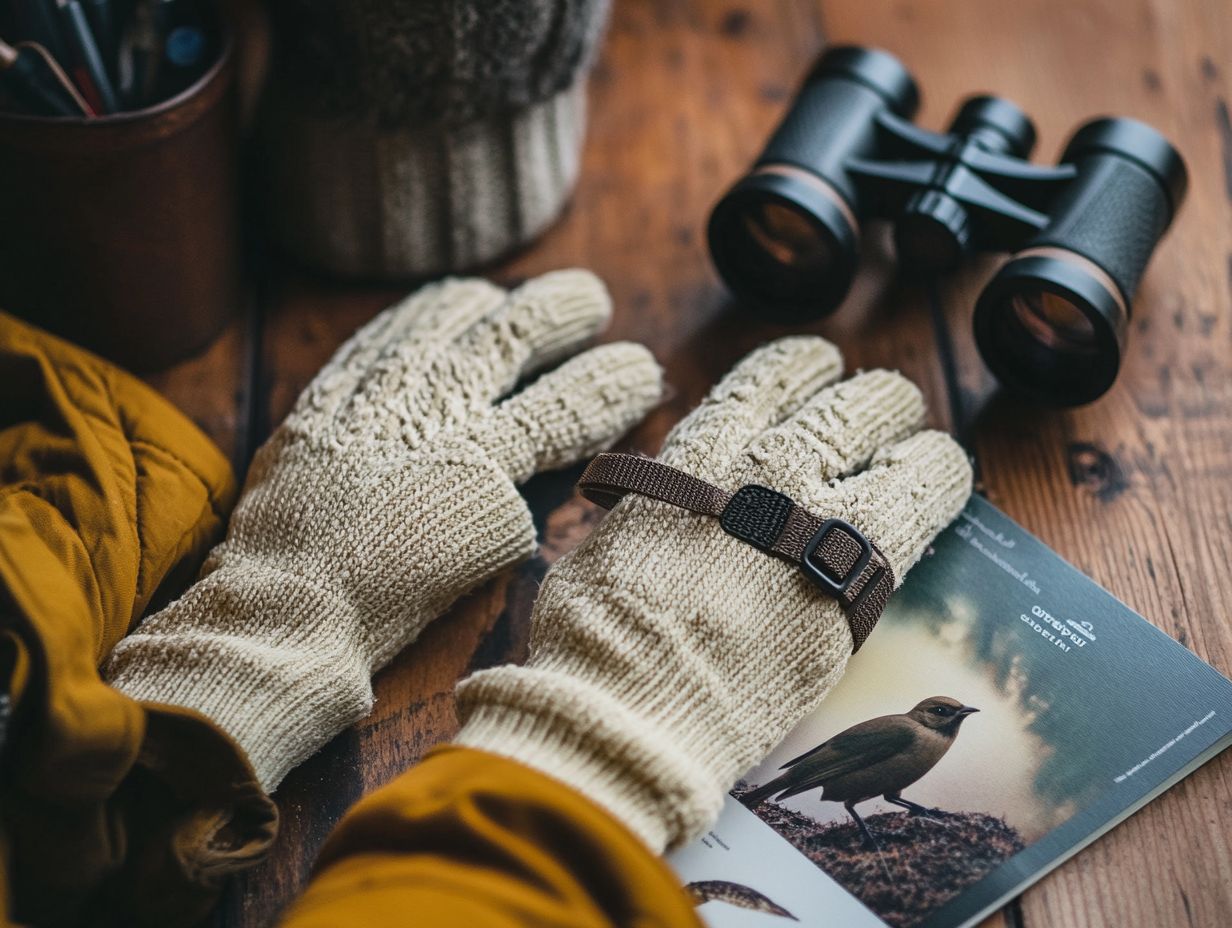
- Choose gloves with the right material and fit for maximum comfort and protection while bird watching.
- Consider the type of glove fingerless or full finger, waterproof or breathable based on your specific needs and preferences.
- Properly caring for your bird watching gloves can help prolong their lifespan and ensure they continue to provide the necessary protection and functionality for your bird watching adventures.
Why Bird Watching Gloves are Important
Bird watching gloves are critical for enthusiasts who brave chilly environments, allowing you to stay comfortable and fully engaged in your passion for observing wildlife.
These specialized gloves are crafted for protection against the elements, utilizing advanced materials like Thinsulate insulation (a lightweight material that keeps you warm) to ensure maximum warmth while preserving your dexterity and grip.
Whether you re embarking on an Arctic excursion or capturing stunning moments at Lake Michigan, the right birding gloves can elevate your experience remarkably, especially during an Arctic excursion.
Protection from Elements and Wildlife
Protection from the elements is crucial for you as a bird watcher, particularly in regions where winter can be unforgiving, with temperatures that plunge and unpredictable weather that can spring up at any moment.
In these challenging conditions, birding gloves become critical. They not only shield your hands from the biting cold but also ensure your safety during wildlife encounters. Gloves made from waterproof materials are especially valuable, keeping moisture at bay, while advanced insulation technologies help retain heat, allowing you to maintain the dexterity needed for optimal binocular use.
For instance, Under Armour ColdGear and Muck Arctic Apres offer excellent thermal insulation without the bulk, ensuring your comfort during those long hours in the field. Pairing these gloves with cozy footwear, like Glerups slippers, can further elevate your warmth, transforming your birding experience into a truly enjoyable adventure, even in the coldest of climates.
Features to Consider in Bird Watching Gloves
When choosing the ideal bird watching gloves, carefully consider several essential features that can significantly enhance your experience. Additionally, it’s important to know what to look for in bird watching clothing, as grip, dexterity, material, and fit play a vital role in how effectively you engage with the beauty of the avian world.
Material and Fit
The material and fit of your bird watching gloves are essential factors that can significantly impact your comfort and functionality during those excursions.
When exploring your options, the decision between natural materials like merino wool and synthetic fabrics is crucial for keeping warm. Merino wool, celebrated for its natural temperature-regulating properties, offers warmth while remaining breathable, ensuring that moisture is effectively controlled to keep your hands dry. On the other hand, synthetic options often shine in durability and quick-drying capabilities key traits for navigating unpredictable weather.
The fit of your gloves can greatly influence your mobility; snug yet flexible designs allow you to handle binoculars or cameras with ease. Additionally, pairing these gloves with lightweight gaiters can provide extra protection against the elements, making every birding adventure not just enjoyable but truly immersive.
Pick your gloves today and enjoy your next bird watching adventure!
Grip and Dexterity
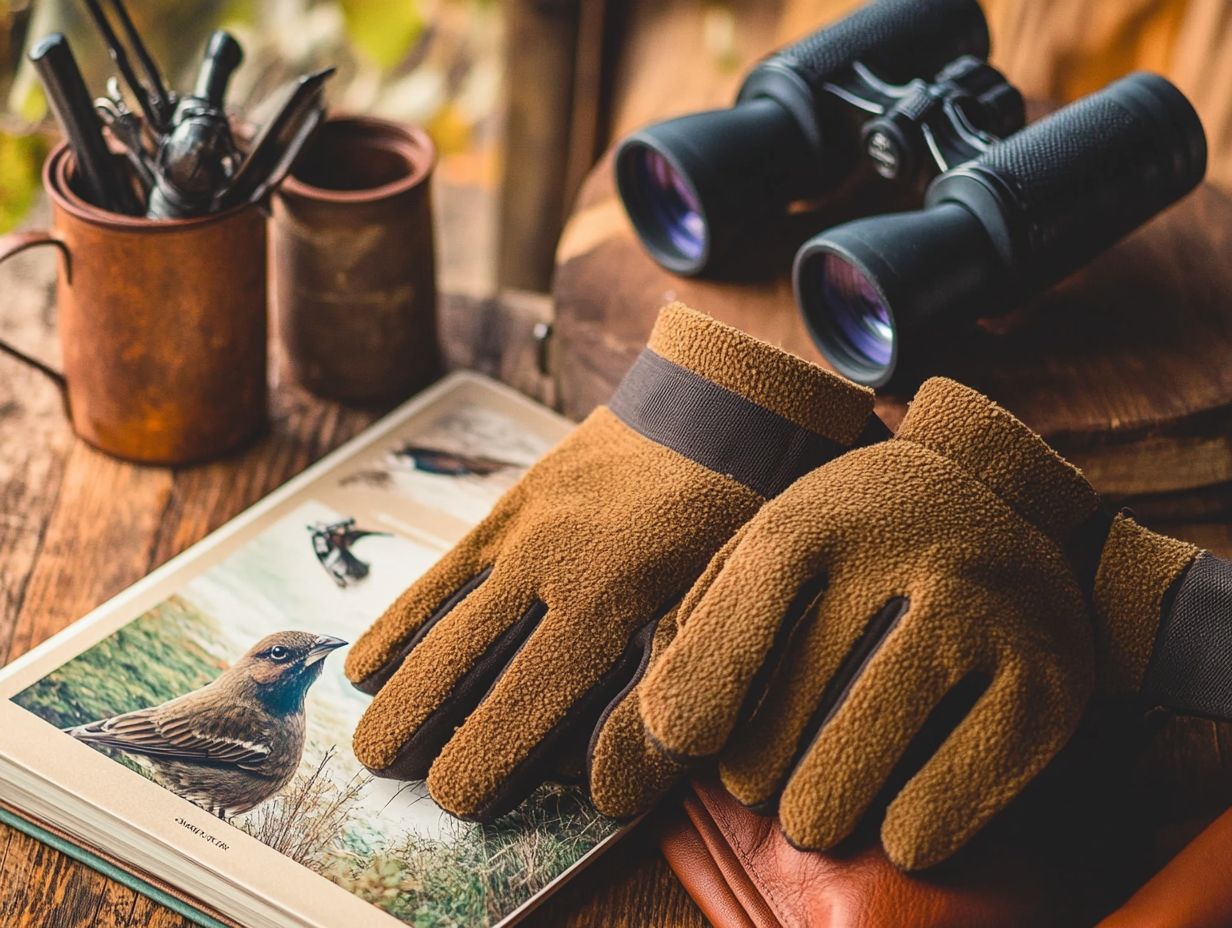
Grip and dexterity are essential features you ll want in your birdwatching gloves, enabling you to handle your equipment effectively even in the coldest weather.
The right blend of materials and thoughtful design can truly enhance these qualities, allowing you to operate your cameras and binoculars with ease. For instance, gloves crafted from silicone or textured leather provide a firmer grip, reducing the risk of dropping your precious gear in chilly environments.
Consider flexible and insulated birdwatching gloves from various brands that not only keep your fingers warm but also offer the dexterity needed to adjust camera settings or focus binoculars effortlessly.
To elevate your experience further, accessories like ergonomic binocular straps and padded camera straps work in harmony with these gloves, ensuring a seamless and enjoyable birding adventure throughout the winter months.
Types of Bird Watching Gloves
Selecting the ideal bird watching gloves can significantly enhance your comfort and effectiveness out in the field. With choices spanning from fingerless to full-finger gloves, each option is carefully made to meet specific needs.
Fingerless vs Full Finger Gloves
When you’re deciding between fingerless and full-finger gloves for bird watching, it’s crucial to weigh the balance between dexterity and warmth, particularly with options like Fox River PrimaHike that enhance your experience.
For those venturing into colder climates, this choice can significantly impact the enjoyment and effectiveness of your birding experience. Fingerless gloves shine in providing that essential dexterity, allowing you to effortlessly adjust your binoculars, pop the lid off your thermos, or manage intricate camera controls without the hassle of removing your gloves.
Full-finger gloves wrap snugly around each digit, enveloping your hands in warmth and shielding them from biting winds. They become invaluable when you’re patiently waiting at a birding spot, where maintaining body heat can enhance your comfort and extend your viewing session.
After all, you wouldn t want to miss the chance to witness an elusive species in flight.
Waterproof vs Breathable Gloves
The decision between waterproof and breathable gloves can greatly influence your comfort and performance while bird watching in diverse weather conditions.
Knowing the unique features of each type is crucial for birdwatchers who want to elevate their experience during winter outings. Waterproof gloves are engineered to repel water, making them perfect for wet or snowy environments.
They ensure your hands remain dry, even in challenging conditions, which is particularly advantageous when photographing birds in the rain or near melting snow. This feature prevents moisture and keeps your grip secure essential when you re capturing that perfect shot!
On the other hand, breathable gloves excel at allowing moisture to escape, promoting temperature regulation and keeping your hands comfortable during vigorous activity. This becomes crucial for longer hikes or extended bird watching sessions, where accumulated sweat could lead to discomfort.
Ultimately, selecting the right gloves tailored to your specific activities and the prevailing weather conditions is key to ensuring a pleasurable outdoor experience.
Choosing the Right Gloves for Your Needs
Choosing the perfect gloves for bird watching requires a thoughtful evaluation of several key factors that include Thinsulate insulation a lightweight material that keeps your hands warm.
You ll want to consider insulation management, your personal preferences, and the specific conditions you expect to encounter during your winter birding excursions.
Each detail contributes to your overall comfort and enjoyment in the field.
Factors to Consider
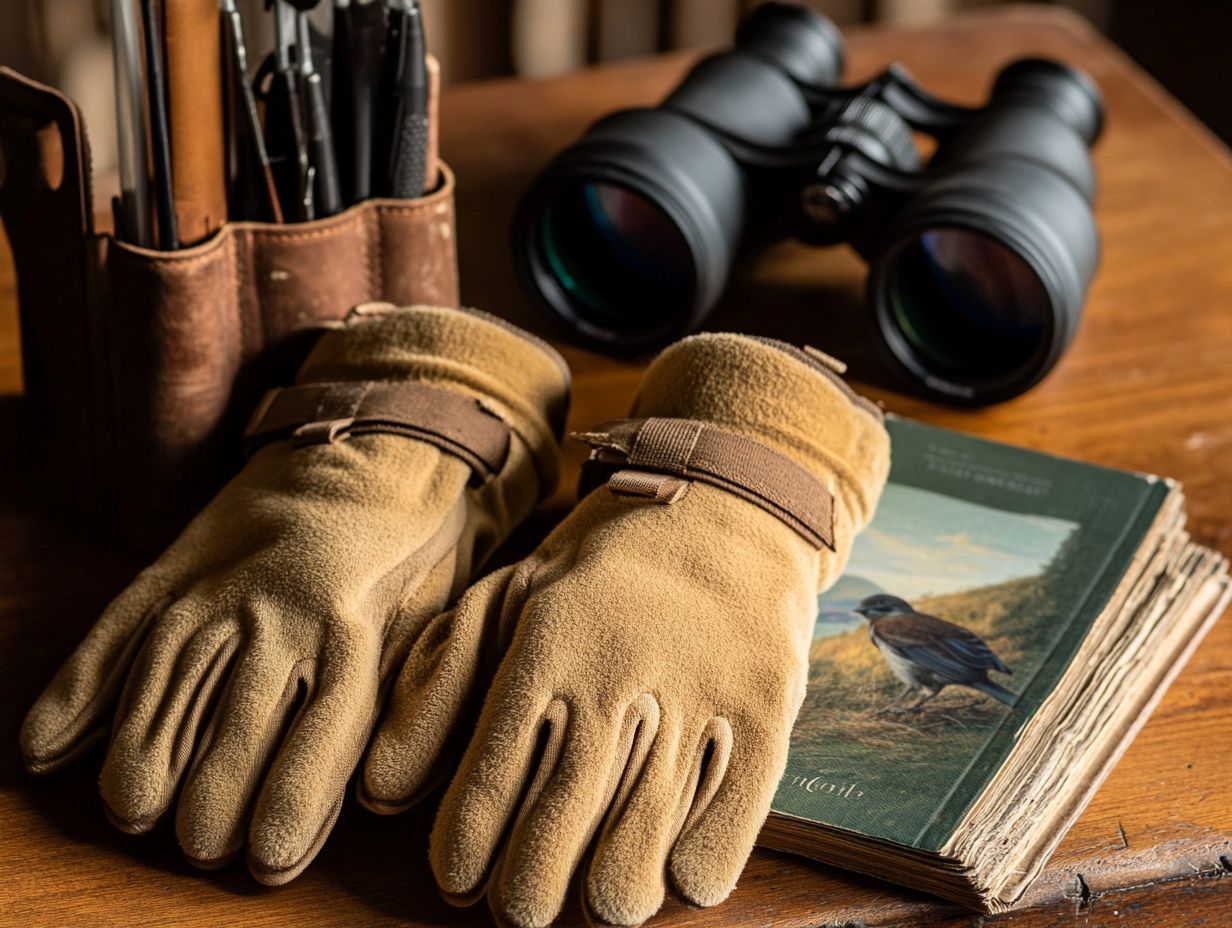
When you’re selecting bird watching gloves, several factors can significantly enhance your experience in the field, including knowing what to look for in bird watching gear.
One of the most crucial considerations is the weather. During those chilly months, insulated gloves are essential to keep your hands warm. In milder temperatures, lighter options that offer better breathability might be ideal.
It s all about finding that sweet spot between warmth and dexterity. You wouldn’t want overly bulky gloves getting in the way of your binoculars or camera, right? Assess your personal preferences, such as your sensitivity to temperature and how much finger movement you need for various bird-watching tasks.
Opt for materials that combine warmth with a snug fit. This way, you can ensure both comfort and functionality, allowing you to focus fully on the breathtaking beauty of nature around you.
Proper Care and Maintenance of Bird Watching Gloves
Caring for and maintaining your bird watching gloves is crucial to keeping them in great shape for your adventures. With the right attention, you can enhance their durability and effectiveness, allowing you to fully enjoy the beauty of nature.
Tips for Prolonging the Lifespan of Your Gloves
To extend the lifespan of your birding gloves, implement effective care tips and proper storage methods.
For instance, keeping these gloves away from excessive heat is crucial; prolonged exposure can lead to material deterioration and a loss of flexibility.
Choosing gentle cleaning products tailored to the fabric type, such as merino wool and Thinsulate insulation a lightweight material that keeps your hands warm will prevent damage and preserve the gloves’ functionality.
After each Arctic Excursion, be sure to store them in a cool, dry place ideally in a breathable bag to avoid moisture buildup.
By adhering to these practices, you can ensure your gloves remain in optimal condition, maximizing their durability and performance in a variety of weather conditions, including winter photography.
Frequently Asked Questions
What should I consider when shopping for bird watching gloves?
When looking for bird watching gloves, there are a few important factors to consider. First, think about the material gloves made of lightweight, breathable material like nylon or polyester are ideal for bird watching.
Next, consider the fit; you want gloves that fit snugly without being too tight. Lastly, think about any additional features like touch-screen compatibility or reinforced grip.
Do I need specialized gloves for bird watching?
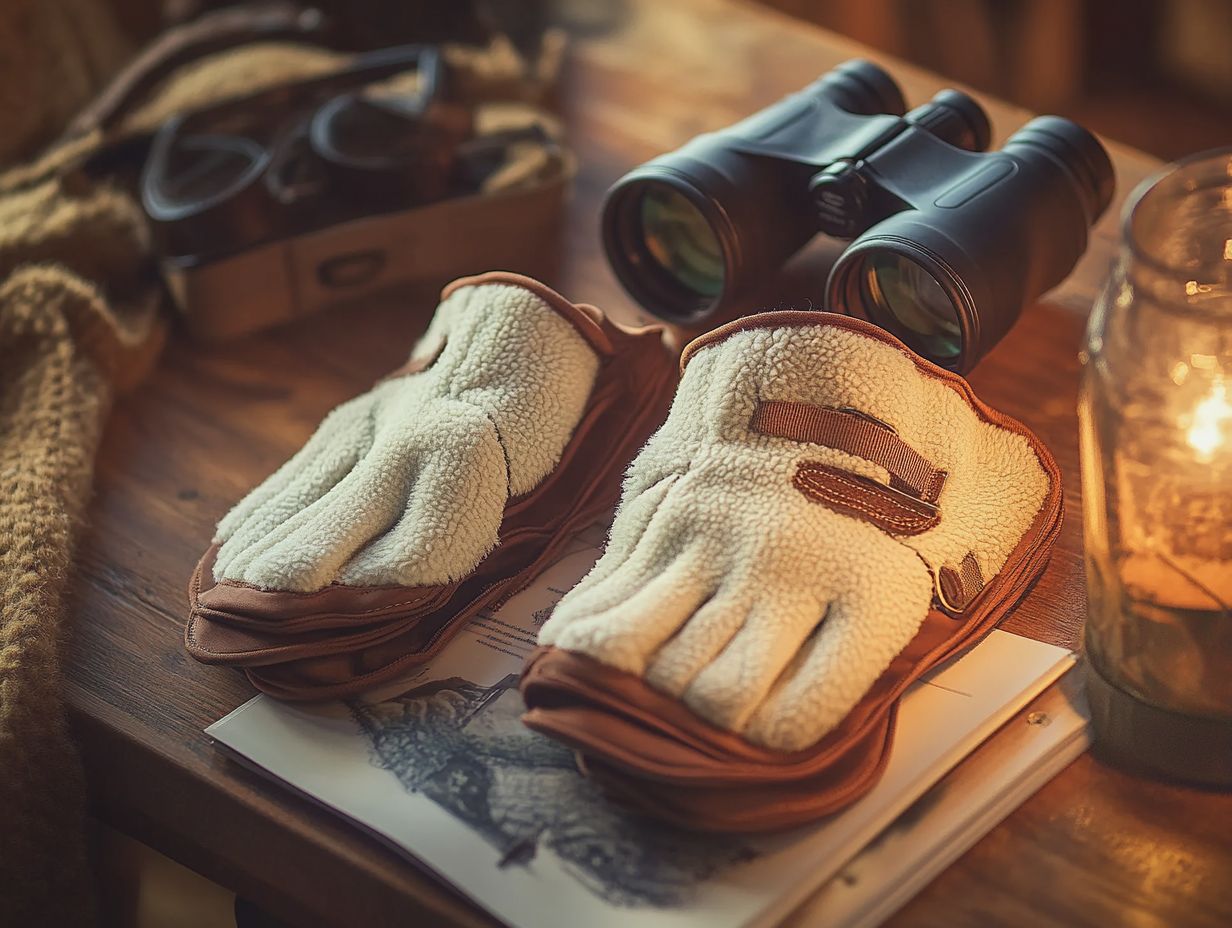
While specialized bird watching gloves are not a necessity, they can greatly enhance your bird watching experience. These gloves are designed with specific features to make bird watching more comfortable and convenient, such as fingerless tips for easy camera use or reinforced fingertips for handling delicate birds.
What type of material is best for bird watching gloves?
Nylon and polyester are great materials for bird watching gloves as they are lightweight, breathable, and quick-drying. Gloves with Thinsulate insulation and waterproof features are also highly recommended for cold and wet conditions.
They provide good dexterity for handling small objects like binoculars or cameras. Some bird watchers prefer leather gloves for added durability and protection against thorns and brush.
Can I use any type of gloves for bird watching?
While you can technically use any type of gloves for bird watching, it is recommended to use ones specifically designed for the activity, such as Muck Arctic Apres or Fox River PrimaHike. Regular gloves may not provide the necessary dexterity and can be too bulky for handling small objects.
Specialized bird watching gloves often have features that make birding more convenient and enjoyable.
Ready to find the perfect gloves for your next bird watching adventure? Start your search today!
What features should I look for in bird watching gloves?
Consider dexterity as the most crucial feature. You need gloves that allow easy finger movement and handling of small objects.
Look for touch-screen compatibility, reinforced grip, and water resistance, especially for winter birding. Gloves with adjustable wrist closures ensure a perfect fit!
How do I know if the gloves will fit me?
When trying on bird watching gloves, they should fit snugly without being too tight. You must be able to move your fingers comfortably and have full motion.
If you’re buying online, always check the sizing chart. Read reviews from other bird watchers for models like Markhof Pro 2.0 and Manzella Bruin to find the right fit!

